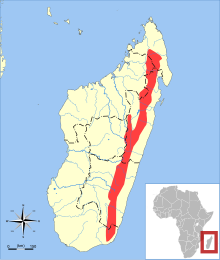Voalavoanala
| Voalavoanala | ||||||||||||
|---|---|---|---|---|---|---|---|---|---|---|---|---|
| Systematics | ||||||||||||
|
||||||||||||
| Scientific name of the genus | ||||||||||||
| Gymnuromys | ||||||||||||
| Forsyth Major , 1896 | ||||||||||||
| Scientific name of the species | ||||||||||||
| Gymnuromys roberti | ||||||||||||
| Forsyth Major , 1896 |
The Voalavoanala ( Gymnuromys roberti ) is a mouse-like rodent species from the subfamily of Madagascar rats (Nesomyinae). The species lives exclusively in eastern Madagascar .
Voalavoanalas show external similarities with house rats , with which they are however not closely related. Their fur is colored black-gray on the upper side, the underside is clearly lighter, white or yellow. The long tail is sparsely hairy and appears bare, it is also dark on the top and light colored on the underside. The broad feet with the relatively long fifth toes are characteristic of the species. These animals reach a head body length of 13 to 17 centimeters, a tail length of 15 to 18 centimeters and a weight of 73 to 124 grams.
The Voalavoanalas are living in forests from 500 to 1800 meters above sea level, they only live on the ground. They are primarily nocturnal, during the day they retreat into earthworks, which consist of a 1 meter long tunnel and a small chamber. Their diet consists of seeds and fruits.
Little is known about reproduction, pregnant females - each with two embryos - were caught in June and July.
Due to the ongoing destruction of their habitat and the competition from introduced rats , Voalavoanalas are listed as endangered ( vulnerable ) by the IUCN .
literature
- Ronald M. Nowak: Walker's Mammals of the World. 2 volumes. 6th edition. Johns Hopkins University Press, Baltimore MD et al. 1999, ISBN 0-8018-5789-9 .
Web links
- Gymnuromys roberti inthe IUCN Red List of Endangered Species 2013.1. Listed by: Goodman, S., Raherisehena, M. & Ramiarinjanahary, H, 2008. Retrieved September 11, 2013.
